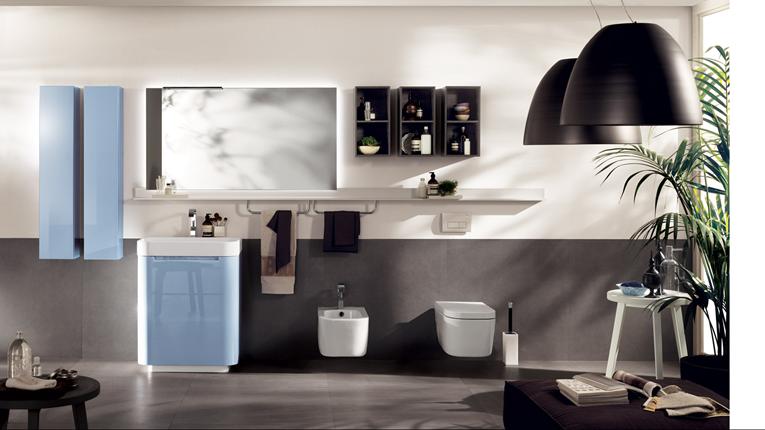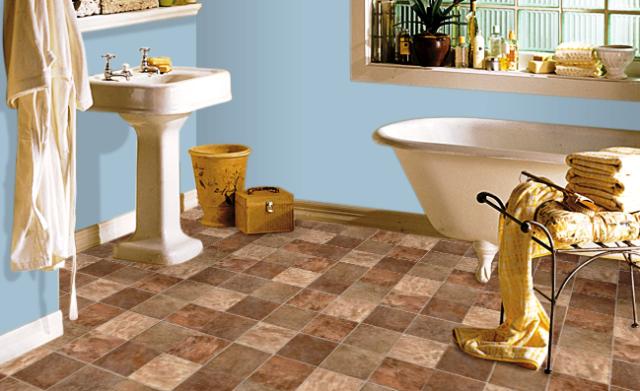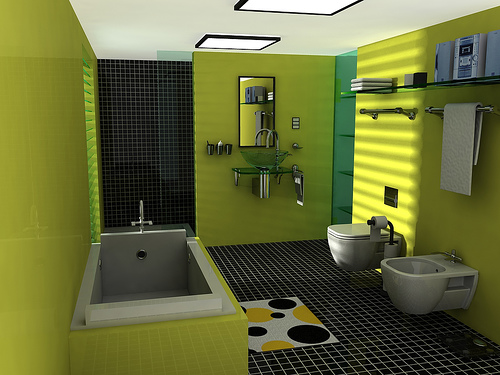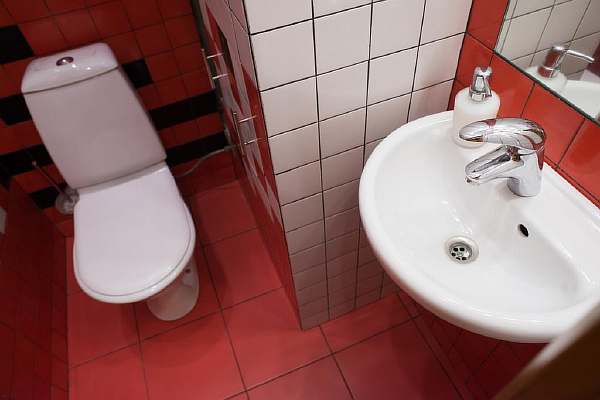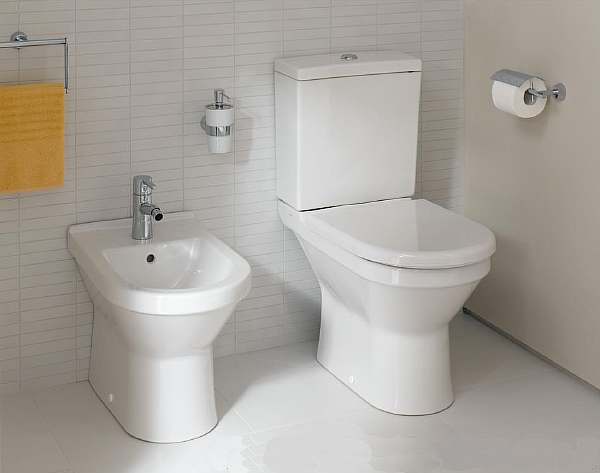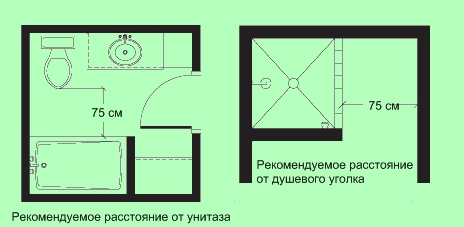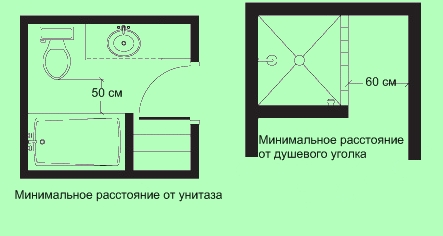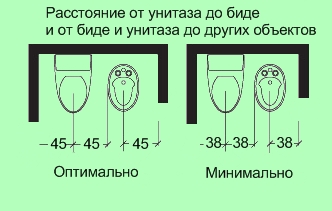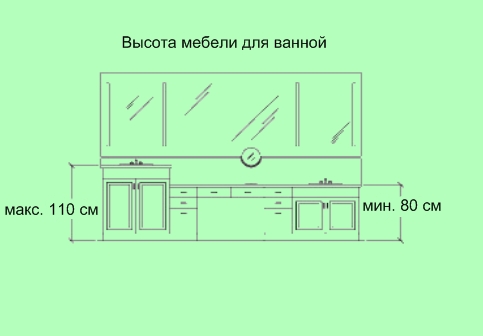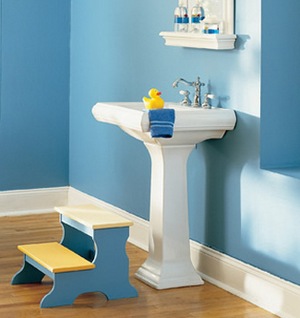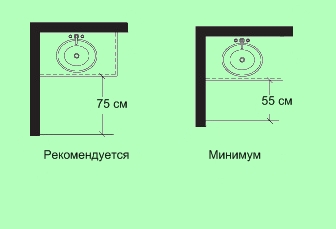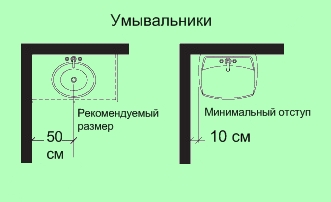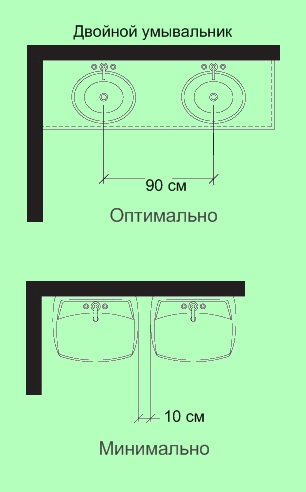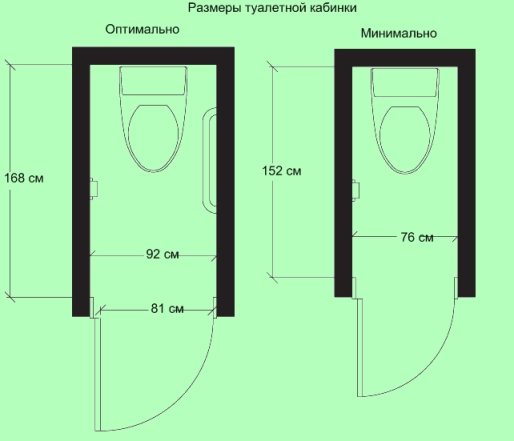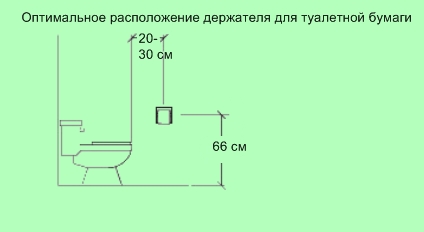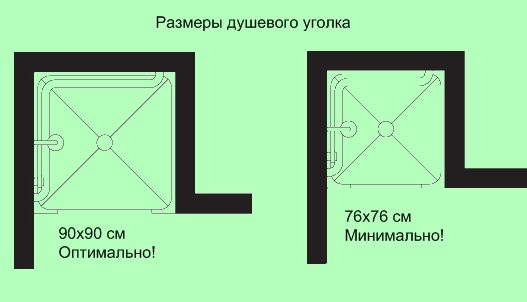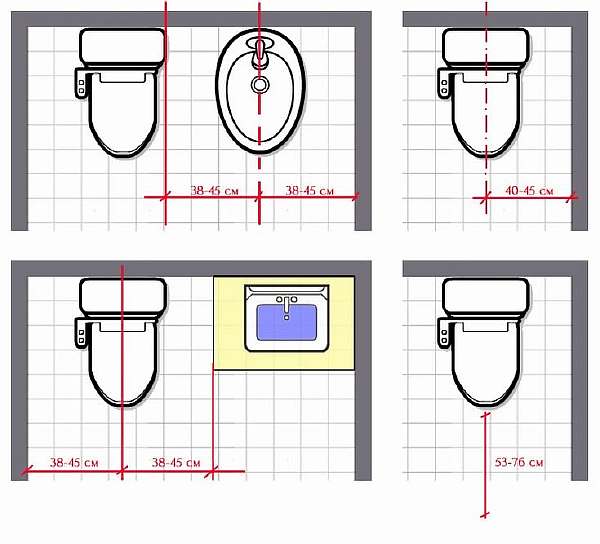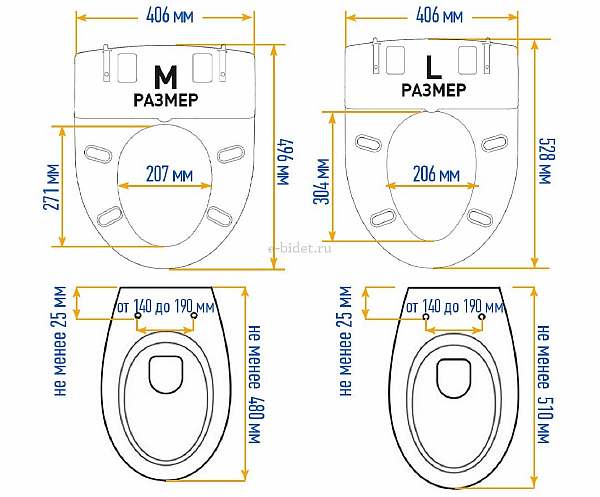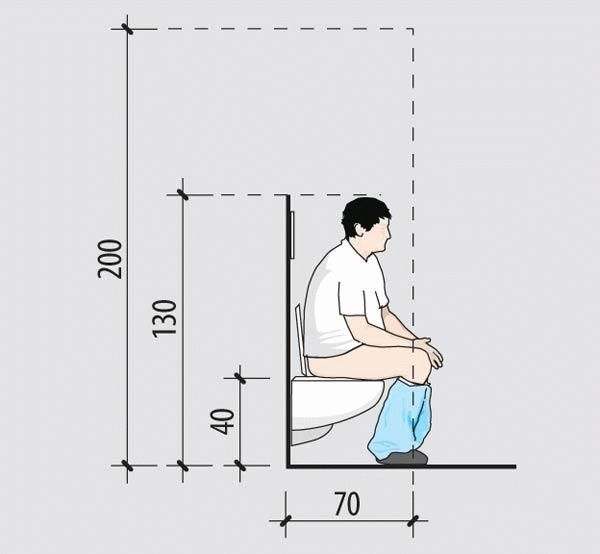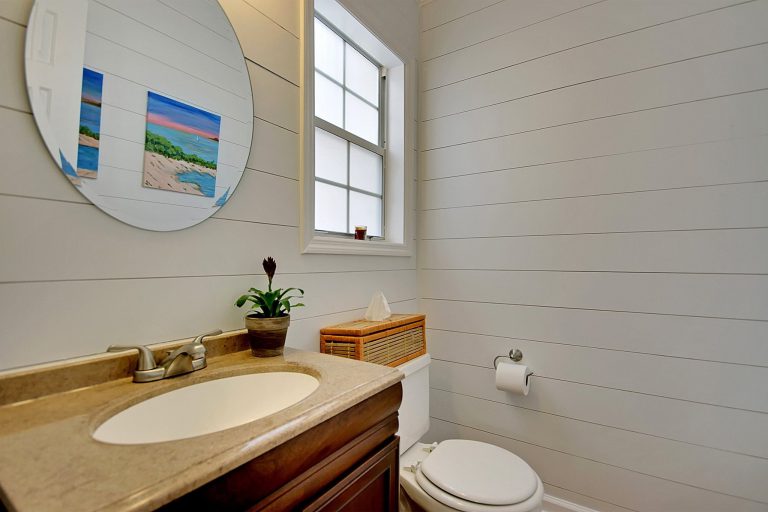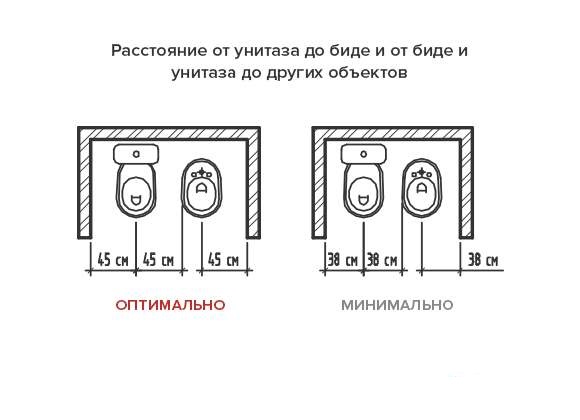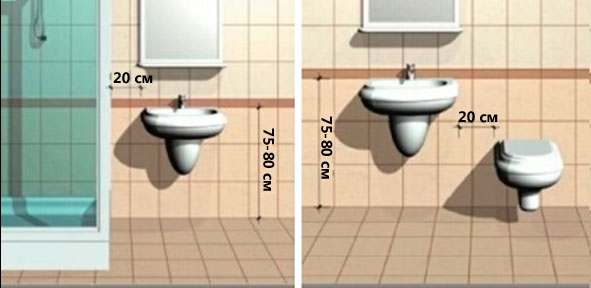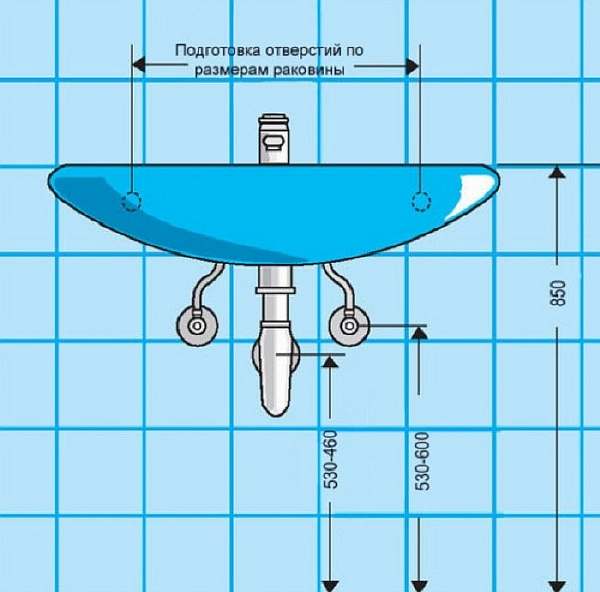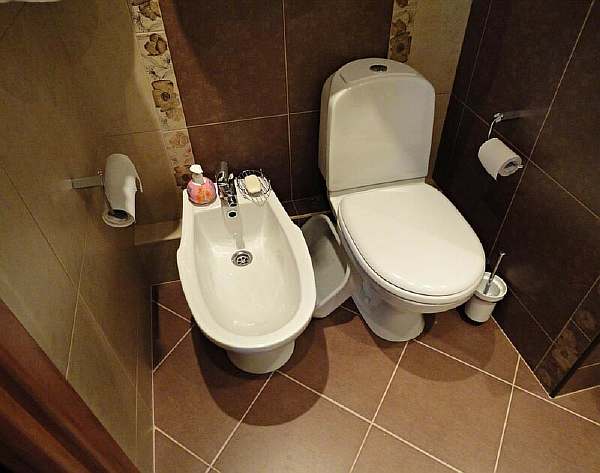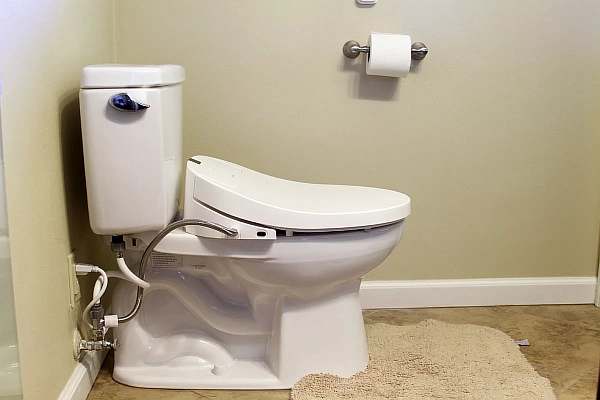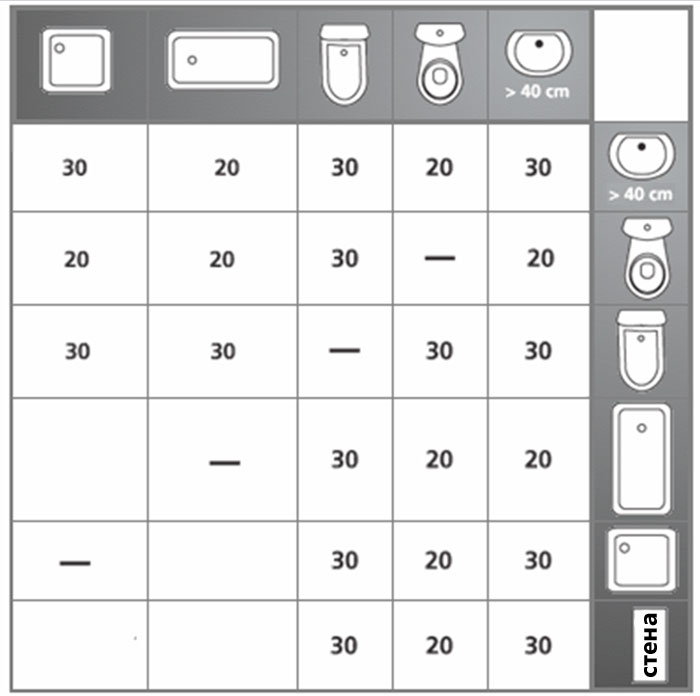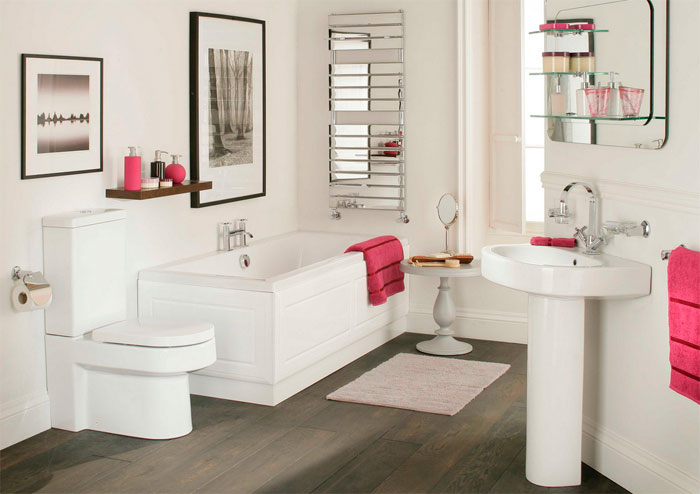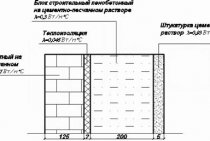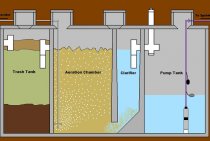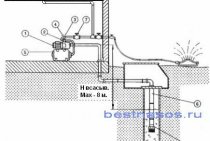Which flooring to choose
For the ergonomics of the bathroom, it is very important to choose the right flooring. The floor must not be slippery as this may lead to accidents.
The main types of materials that are used in bathrooms and toilets are:
Tiles in the toilet
- Non-slip ceramic tiles;
- Laminate;
- Linoleum.
You need to choose very carefully. It should have a slightly rough structure so that there is no slip when wet. Usually, Italian ceramic tiles are much better than domestic ones and have a longer service life. Tile flooring has many advantages:
- Such a coating is resistant to abrasion, it can be safely washed and cleaned;
- moisture resistance;
- Durability;
- Beautiful appearance.
There is only one drawback - ceramic tiles are afraid of mechanical damage, you cannot drop various objects on it, as it can permanently deteriorate.
Choosing a laminate for a bathtub, you get a beautiful floor covering that can imitate expensive wood species. Even a novice master can lay laminate in the bathroom, the main thing is to fit the joints well. If the joints are poorly fitted, then moisture can get into them and the laminate will be deformed and damaged. It is desirable to lay special rugs on top of the laminate, such a coating becomes slippery when water enters.
Bathroom linoleum
You can lay linoleum in the bathroom. This flooring is inexpensive, beautiful, not afraid of moisture, it is easy to lay on the floor. However, when wet, linoleum is very slippery, so it is also necessary to use special bathroom rugs.
Warm floors in bathrooms have proven themselves well, this is especially true for combined toilets with a bath. It is pleasant to stand on such floors with bare feet and it does not require an additional source of heating in the room.
How to rationally equip a bathroom
In a modern dwelling, whether it is a typical apartment or a private house, both a bathroom and a toilet room, or their combined version, are always assumed. In most cases, they are not too large, but it is quite possible to allocate the necessary space for a sanitary area and a bathing area. Before purchasing plumbing, you need to measure the area of \u200b\u200bthe room and determine the places for the sink, bathtub and other equipment, taking into account the recommended rules and regulations for their installation.
The bidet is recommended to be installed next to the toilet, at a distance of at least 60 cm.
Organizing the space in the bathroom, you should take into account ergonomics and observe the rationality of placement. It is necessary to determine in advance and accurately the maximum comfortable distance between the toilet and the bidet. There are no clear regulations on the magnitude of this distance, its choice is quite arbitrary, but it must be borne in mind that the distance from the sewer riser to the toilet bowl is 1 m, and the rest of the plumbing is located no further than 3 m.
It is desirable to make a free distance in front of each device at least 60 cm (a platform of 70x100 cm will be more convenient), and 25-30 cm should be left on each side. Directly, the distance between the bidet and the toilet, according to the advice of experts, can be made from 30 cm to 45 cm A smaller distance for using plumbing will not be enough, and with a larger one it will not be very convenient. From the appliances to the washbasin, if it is provided in the sanitary zone, a gap of at least 25 cm is allocated.
The distance from the wall to the toilet is the optimal layout
During the repair of the toilet and bathroom, when replacing plumbing, the problem of the correct layout of the bathroom appears.One of the most important convenience parameters is the distance between the toilet and the wall, because if it is chosen incorrectly, it will be uncomfortable to use the device.
We will consider regulatory requirements and find out what specific basic distances the instruction defines.
Bathroom redevelopment
Separate toilet seat
Let's start with a more simple case, when the toilet is separated from the bathroom. It is simpler due to the fact that in such a toilet, in most cases, there is one device. In a large configuration, it is possible to add a bidet, if the size of the room allows.
We will immediately announce the norms for the distance from the wall to the toilet, adopted in SNiP 2.08.01-89 * "Residential buildings":
Note! Official norms are mandatory for public and private construction of facilities. The owners of the apartments will be able not to make them and place the devices at their discretion, since their operation and maintenance is carried out by them
be directed to state that these standards are relevant in the case when the toilet is spacious enough, and you do not understand where it is better to put this or that device. But in most post-Soviet apartments, such a nuisance does not appear, since the dimensions of the toilet are minimal, and the toilet is placed in the middle of the cubicle near the back wall.
Note! Most of the toilet cubicles of the Soviet era have dimensions in which the installation of a compact exactly in the middle of the room near the back wall gives the very minimum distances to the side walls and the front door. Combined bathroom
Combined bathroom
If the toilet and bathroom are in the same room, the task is slightly complicated by the fact that you need to rationally place a couple of plumbing fixtures in a rather small room.
Additional troubles may lead to the need to install household appliances - a washing machine, boiler, etc. Along with this, the most acceptable layout option involves not only rational and ergonomic, but also harmonious placement of all objects from the standpoint of design.
This is another feature of modernity: people want to live comfortably and beautifully, and this, as we know, cannot be forbidden.
If the bathroom is large, then you need to divide its premises into territories: the territory of the shower or bath, the territory of the washbasin, the territory of the toilet, etc. But in most Soviet and many modern apartments, there is no expanse, and the task is to fulfill the minimum requirements for the distance between adjacent devices, devices and walls and the presence of passages.
Quite often, a compact and a bidet, and from time to time a washbasin, are placed in a line against the wall. In this case, there should be a gap of at least 20 cm between adjacent devices, preferably 30 cm. This refers to the distance from edge to edge.
If there is a sink next to the toilet, along with this, the approach to it is carried out from the side of the device, then you need to remember about the space for tilting: during washing, the person leans towards the sink and moves back a little. The minimum space for this should be at least 70 cm.
Note! The dimensions of the distances to the side walls are accepted without transformations - 38 - 45 cm from the middle axis of the bowl to the wall. Similarly, the requirement for a distance in front of the toilet does not change - it forms at least 53 cm, for comfortable use - 76 cm
Here it is possible to make adjustments only in a huge direction.
For combined bathrooms, the issue of saving space is very relevant. One example of such savings is a toilet with a tank in the wall. Do-it-yourself installation of this model is complicated, but the use of modern installations and kits with frames simplifies this task.
When redeveloping bathrooms and latrines, you should take into account the distances between adjacent devices, and do not forget about the indents from the wall (see also the article “Bidet toilet bowl: purpose and design features”).
Ergonomics of the bathroom and toilet rooms
13.03.2009 17:54
Views: 128932
(60 ratings, average: 4.17 out of 5)
To My World
Every time a renovation is planned, it is necessary to start it from the so-called wet areas - these are the bathroom, toilet and kitchen. These rooms are the most difficult when planning and calculating an ergonomic space.
When reconstructing (repairing) the bathroom, the necessary conditions are taken into account, namely:
- The toilet bowl must be located near the sewer riser, if this is not taken into account, then the toilet bowl is placed above the floor level.
- The sink must be placed at a height of 85-90 cm from the floor level.
- In small bathrooms (less than 15 m2), for safety reasons, it is forbidden to install sockets and switches, they are located in front of the entrance to the room.
- In cases where the bathroom is larger than 15 m2, you can install sockets for various appliances: heated towel rails, hair dryers, saunas, TVs and even electric fireplaces.
- Towel dryers are located next to the riser for connecting to hot water. Electric heated towel rails are installed at any height from the floor and next to the outlet.
Ventilation
In bathrooms, especially in bathrooms, in order to prevent mold and fungus from forming, good ventilation is necessary. It is possible to connect forced ventilation.
Warm floor
They can be either electric or flexible pipes with hot water. Connection and control panels for electric floors are taken out in front of the door to the bathroom.
Toilet bowls
There are floor-standing with a cistern (compact), floor-standing with a built-in cistern, hanging, and also combined with a bidet. Wall-mounted toilets require additional space to fit the cistern into the wall.
| The optimal size of the floor toilet | Optimum washbasin dimensions |
Bidet
There are floor and hanging. It is better to buy complete with a toilet bowl, in order to comply with the style and shape, the same design (in hanging sets, all communications should be hidden under one panel). The bidet is installed next to the toilet at a distance of 15-20 cm.
sinks
There are ceramic, glass, steel, acrylic, stone and wood. According to the type of attachment, they are divided into console sinks attached to the wall with brackets, standing on a stand (tulip type) and built-in sinks. The standard sink depth is 45 cm. The length of double sinks is 120-150 cm. The distance between the sink and the shower cabin or the bathroom should be at least 30 cm.
| Necessary optimal dimensions for washing in the bathroom |
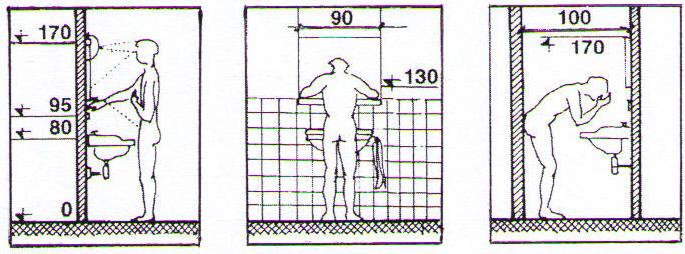 |
| Necessary optimal dimensions for wiping with a towel in the bathroom |
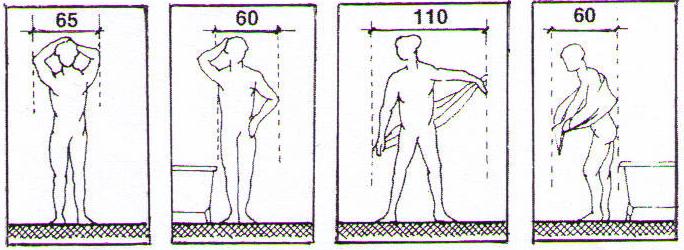 |
Baths
There is a rich variety of bathtubs made from different materials: Cast iron. They heat up quickly and keep warm for a long time. Such baths are not subject to corrosion. The limitation is only in design, there are no other shapes than rectangular ones. Steel. Durable surface, but does not hold heat well. Acrylic (plastic). Such baths are durable, but do not hold heat. There are various shapes and sizes. Quaryl (a mixture of acrylic with quartz powder). They hold heat well, are durable and scratch resistant. There are also Wooden, Onyx, Marble and Steel baths. For functionality, there are ordinary and hydromassage baths. The choice of a bath depends on the size of the bathroom. There is a direct relationship between the height and length of the baths - the longer they are, the lower their height. Common bath sizes are 170x70 cm. There are also sit-down baths 150x70 and 120x70 cm long.
| Standard dimensions of a rectangular bath | Standard dimensions of a round bath |
| Standard dimensions of a corner bath | |
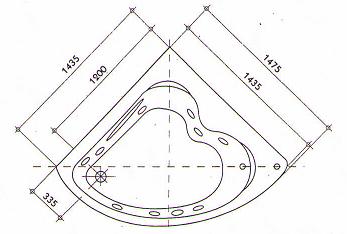 |
Shower cabins
There are shower cabins of various shapes and sizes. They are divided into simple and combined. Simple ones come with a pallet of various shapes and glass or plastic walls-doors. Trays in shower cabins can be: ceramic, steel, cast iron, acrylic, marble chips. The minimum size of the shower tray is 80x80 cm. They save a lot of space in the bathroom.
| Various options for placing sanitary ware in bathrooms | |
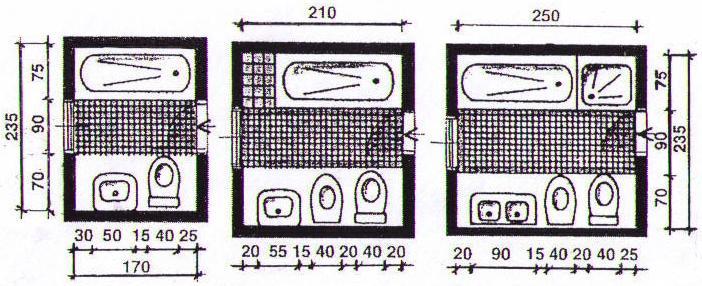 |
|
 |
|
 |
|
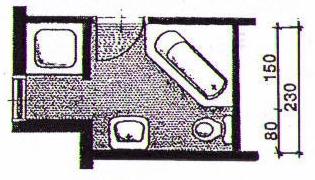 |
| Various options for placing plumbing in showers and toilets | ||
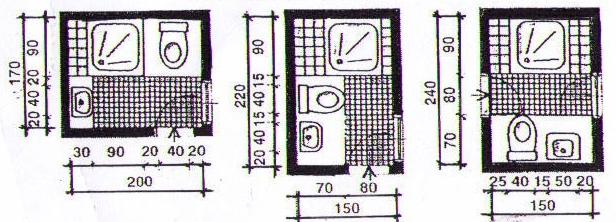 |
||
| Next > |
|---|
Updated ( 14.03.2009 20:50 )
Norms SNiP 2.08.01-89
Until recently, the Russian Federation mainly used the standards of the Soviet state, which paid great attention to the construction, production, epidemiological and industrial safety of its citizens.
Recognizing the expediency of the data presented in these documents, obtained not just by experience, but also on the basis of scientific research, the rules and regulations were nevertheless used at the level of recommendations.
The court took them into account when resolving disputes, but could also ignore them. The creation of a state register of normative recommendations, norms and rules, as well as methodological guidelines has led to the fact that the developed norms and rules in the field of construction, production and the national economy have acquired the status of official and legislatively enshrined
The main condition for acceptance was compliance with the norms of Russian law
The creation of a state register of normative recommendations, norms and rules, as well as methodological guidelines has led to the fact that the developed norms and rules in the field of construction, production and the national economy have acquired the status of official and legally enshrined. The main condition for acceptance was compliance with the norms of Russian law.
Sanitary and hygienic norms (SanPiN) not only have not become outdated, but have become even more relevant due to the deteriorating epidemiological and environmental situation. None of the adopted sets of rules, according to the laws of the Russian Federation and the decrees of the Ministry of Health, should not conflict with the norms of sanitation and hygiene.
dimensions and distances
Designers, clinicians and manufacturers of bathroom equipment have long paid attention to
ergonomics of the bathroom. The results of numerous studies have made it possible to determine the sizes of equipment suitable for 90% of people and its rational placement.
The remaining 10%, who are larger, either have to endure the inconvenience or increase the numbers by acquiring larger showers and leaving more space between bathroom elements.
Unfortunately, bathrooms are often so small that ergonomics can only be dreamed of. However, it is worth at least approximately following the rules, taking into account the available opportunities. Ideally, 75 cm of free space should be left between each piece of plumbing equipment, as well as between the equipment and the wall / door.
This does not apply to toilets and bidets.
should be approximately
from 35 to 45 cm
. If you leave a long distance, it can be inconvenient.
Distance from shower or bathtub to sink
can also be shortened
up to 30 cm
, but no less than that. The wash basin must be above the floor
at a height of 80-110 cm
. Ideally - 90 cm, unless, of course, people of average height use the bathroom.
In principle, it should be the same
bathroom furniture countertop height
(tables, cabinets, chests of drawers, moidodyrs, etc.).
If children do not have their own bathroom, you need to take care of a comfortable bench so that the child can freely perform hygiene procedures while looking at his reflection in the mirror.
Washing over the sink, a person bends over, which means that there should be enough space in front of the washbasin for this. It is impossible to mount the washbasin in a cramped nook if there is no free space equal to
at least 55 cm
.
However, there should be enough space so that a person, washing his face and brushing his teeth, does not rest his elbows on the walls.
As for the toilet
, then to the right and left of it should be
not less than 35-45 cm
- It doesn't matter if there are walls or other pieces of equipment.
There must be at least 50 cm in front of the toilet
regardless of what is located there - a door, a shower cabin or a sink. Better if
in front of the toilet
will be left
not less than 75 cm
If this
toilet cubicle
, then its average size should be
168 by 92 cm
Better if
in front of the toilet
will be left
not less than 75 cm
. If this
toilet cubicle
, then its average size should be
168 by 92 cm
.
Need to mount a little
in front of the edge of the toilet (20-30 cm)
.
Toilet paper holder height
from the floor
60-70 cm
.
If equipped
fixed shower enclosure
, then its size should be
not less than 75 by 75 cm
, and this is on condition that people of average build will take a shower. Ideally,
shower enclosure or shower cubicle
must be
not less than 90 by 90 cm
.
SNiP Residential buildings on distance standards
The rules contained in the regulatory document are mandatory for the construction of any type of buildings - industrial, public, medical, educational and residential. However, there is an unspoken opinion that the owners of premises in residential buildings and private buildings can deviate from the dictated norms if they themselves perform their maintenance and operation.
Basically, such a retreat is made by the owners of premises with bathrooms, combined or frankly small. If the toilet is spacious enough, it is better to follow the established rules in order to use special rooms with convenience and safety:
- to the front (front) wall or wall with a door, if we are talking about a small toilet, the minimum distance is 53 cm. This is enough to not feel constraint in the knee joint area;
- the maximum required distance from the frontal plane located in front of the seated person is 76 cm;
- the maximum distance in front does not particularly need to be normalized, and if possible, the functional area for a person can be more than a meter;
- from the middle axis of the toilet bowl to the wall on the side, the established minimum is 40 cm. In some sources, it is determined at 38 cm;
- the optimal distance from the central axis of the toilet bowl is 45 cm. This is enough for comfortable operation of the plumbing fixture. But no one forbids installing at a greater distance, if the parameters of the allotted room allow it;
- in a separate toilet, the distance between the toilet and the wall on the left in standard buildings is usually equal to the distance to the wall on the side on the right;
- the location of the toilet in the toilet room is usually the center of the room, because the sewer pipe is brought here. This also determines the position of the remaining toilets on the riser on the floors above and below;
- the second option for placing plumbing equipment is closer to the back wall. This does not make it possible to equip the semblance of shelves or racks, but it is typical for the minimum dimensions of the toilet in apartments of typical development, where the bathroom is separate;
- the toilet cubicle in the houses of the Soviet era was built in size, when the central placement gave the necessary distances to the side wall and the front surface with the front door located in it.
When arranging a shared bathroom, there are certain conditions that must be observed.These are the norms for the distance between the toilet bowl and other interior items, which should be followed, even minimally.
But this is not a suitable option if the dimensions of one of the family members do not correspond to the average figures for which the standards of building rules and regulations are calculated.
Other mounting details
As you can see, a lot of nuances and problems lie in the installation of the toilet. The distance from the wall in this case is no less important than others, so experts recommend planning this kind of work in advance so as not to forget anything and do everything in accordance with the rules.
Please note that when raising the toilet bowl above the base of the floor, it is not recommended to use wood for this purpose, since this material is susceptible to decay as a result of the adverse effects of condensate. Having moved the plumbing fixture to an acceptable distance from the wall to the toilet bowl on the side (the numbers are indicated above) and having mounted the device, it is recommended to pour a concrete screed, which additionally involves the use of screws, dowels and special fixtures for plumbing
Only in this way the device will be securely fixed, and you can enjoy the comfortable use of plumbing without worrying about breakage.
Having moved the plumbing fixture to an acceptable distance from the wall to the toilet bowl on the side (the numbers are indicated above) and having mounted the device, it is recommended to pour a concrete screed, which additionally involves the use of screws, dowels and special fixtures for plumbing. Only in this way will the device be securely fixed, and you can enjoy the comfortable use of plumbing without worrying about breakage.
Now you know what rules and regulations should be used. The distance from the wall to the toilet is an important indicator that makes daily use of the toilet room easier and more comfortable. When faced with the need for redevelopment, the study of this kind of material will help to avoid common mistakes that are so often made by repairmen who started redevelopment on their own.
Why the bathroom should be ergonomic
The toilet is one of the most used rooms in any home. The use of various plumbing devices should be safe and practical, and the overall decor of the toilet room should be pleasing to the eye. If all the rules for arranging plumbing are followed and repairs are made in accordance with the standards, then using the bathroom will be comfortable and convenient.
In the process of repairing a bathroom, in order for this room to be functional and comfortable as a result, certain rules must be observed that determine the minimum dimensions of plumbing and the distance between individual parts of the equipment. At the same time, the space in this room will be organized in such a way that all the planned devices will fit in it, in addition, you will be able to use them freely and comfortably. The main and indispensable devices, of course, are the toilet and sink. You must properly plan the placement of furniture and shelves. Often in this room it is also necessary to find a place for a washing machine.
If you have already decided which pieces of furniture, fixtures and equipment will be placed in the bathroom, you can start planning their location, taking into account the correct distances. Before proceeding with the planning of the bathroom interior design, it is necessary to know the distance from the toilet bowl to the wall, the norms that are established in order to comply with sanitary and hygienic requirements, as well as to ensure convenience when using plumbing.
Bathroom lighting
An ergonomic toilet or a combined bathroom is characterized by good and practical lighting. Built-in light bulbs look good, as well as additional light sources that illuminate individual areas. There must be a small lamp near the washbasin that will illuminate the washing person well.Above the bathroom, the light should be more diffused and softer so that you can relax after a hard day's work. It is good when economical night lighting is provided in the bathroom, which will allow you to use the room without turning on the main light.
Average social standards
The norms for installing a toilet from the wall are the results of measurements, studies, social and statistical surveys that allow us to develop standards for in-line production. Some of them are included in GOSTs and SanPiN, have become standard standards for the sale of industrial products in construction markets and building materials supermarkets.
The children's toilet bowl was developed according to the standards obtained in pediatrics, where there are standard standards for each age - weight, height. Children who do not meet age standards have to adapt in any preschool educational institution - whether it is kindergarten or school.
At home, not everyone has extra square meters and funds to install a special device. It is much more rational to use a special stand for the toilet. Social regulations refer to standardized equipment and room sizes.
If there are people who do not meet these parameters, they experience inconvenience or (if they have significant funds) create toilet rooms and buy non-standard toilet bowls. The average dimensions are as follows:
- The most common size of the toilet bowl: the height of the bowl is 40 cm, the tank is 81.5 cm, the drain pipe rises by 185 cm. The compact itself is most often 65 cm long and 35 cm wide. From this it turns out that from the central axis of the device to its edges can be at least 17.5 cm if it is an adult, and not a children's version. Then it is clear from what considerations on the construction forum, when asked how many centimeters should be the minimum distance, they write that it can be 38 cm, and the distance from the toilet to the wall on the side is at least 20 cm. In total, 17.5 cm (almost 18 cm) from the central (longitudinal) axis of the bowl and 20 cm recommended to the wall, and give those 38 cm (minimum). And if you follow the SNiP standards and make 45 cm from the axis to the wall, then this will be the optimal average parameter, convenient for most people.
- For a toilet room in building standards, 80 cm wide and 1 m 20 cm long are considered sufficient for a comfortable stay and the administration of natural needs. When refurbishing old secondary housing, the length and width are often made smaller. Sometimes meters in the hallway or kitchen win this way. At the same time, they usually bring the bathroom and toilet together or expand the space by changing the layout of the bathroom and installing a shower stall. But in houses of mass standard development with a separate toilet, there is often a dimension determined by GOST and SNiP, which complies with SanPiN standards and provides maximum convenience to people living in an apartment.
The nuances of installing a toilet
The minimum distance from the toilet bowl in the frontal part cannot be less than 53 cm, otherwise the administration of natural needs will become problematic and harm health. The optimal functional space in the frontal part is 75 cm. It is not limited in the direction of increase, but if this is not possible in the combined bathroom, then a toilet bowl with a tank in the wall or suspended is used.
The equipment of a combined bathroom, according to existing needs, presents particular difficulties in a small apartment. In this case, they resort to installing a shower instead of a bath and draw up a scheme in which none of the devices will block access to the other during operation, or at least cause minor inconvenience.
These standards are easily met when using standard designs and types of sinks, bidets, toilets, washbasins.But if an unusual, exotic shape or unusual dimensions is acquired, careful measurements must be taken so as not to experience difficulties during installation or not to be left with new equipment, the installation of which under existing conditions will be impossible.
Distances between plumbing elements
In order to safely and conveniently use the bathroom, certain minimum gaps between its elements must be observed.
Distances between plumbing elements:
- between a sink with a width of more than 40 cm and another sink - 30 cm;
- between the toilet and washbasin, as well as the bath and shower - 20 cm;
- sink and bidet, as well as a shower cabin - 30 cm;
- from the toilet to the bidet - 30 cm;
- between the bathtub and the washbasin - 20 cm;
- from bath to bidet - 30 cm;
- from shower to bidet - 30 cm;
- between the wall and the sink - 30 cm;
- distance from the toilet to the wall - 20 cm;
- from the wall and bidet - 30 cm.
Considering these recommendations, you will be able to ergonomically arrange your bathroom so that the use of sanitary ware is comfortable, easy to care for and keep it clean. Various design tricks will help to realize these plans even in the smallest room, for example, you can see how to place the washing machine (under the countertop of the sink or in a niche), choosing a convenient bathroom or washbasin configuration to save space.
It is very important to observe these parameters in the bathroom, despite the seeming simplicity of this issue. In fact, it is almost impossible to organize such a room without observing these parameters in compliance with all sanitary standards and safety precautions.
In addition, such standards provide a fairly comfortable use of all plumbing for all family members, as well as for your guests, regardless of their physique. Such standards also provide the opportunity to conduct a thorough cleaning in the bathroom and treatment with special products, if necessary.
Therefore, before you start planning, you should collect all the dimensions of the plumbing and equipment that we plan to install. In this case, you need to go shopping and write down all the dimensions of the planned equipment. It is advisable to look at alternatives in advance and record all the data for several options. Then you need to correctly measure the dimensions of the room and draw a plan for the placement of all elements on a piece of paper. For this, it is convenient to use graph paper, but if it is not at hand, then a simple sheet in a box from a school notebook will do.
https://youtube.com/watch?v=NJuU1zZiAGQ
